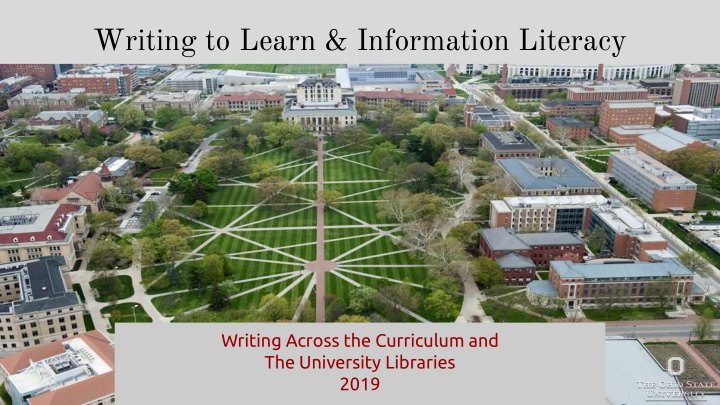



Writing to Learn & Information Literacy Writing Across the Curriculum and The University Libraries 2019
Presentation Outline ● Overview of information literacy concepts ● Discuss writing strategies to support critical thinking and inquiry ● Review resources available through University Libraries and the Writing Center
Think of a time when you gave your students a research-based assignment. What did the students do well? In what ways did students seem to struggle or fall short of meeting your expectations? (photo courtesy of UCD School of Medicine)
From https://www.decodingthedisciplines.org/
What is information literacy? Information literacy is the set of integrated abilities encompassing the reflective discovery of information, the understanding of how information is produced and valued, and the use of information in creating new knowledge and participating ethically in communities of learning. -Association of College & Research Libraries (ACRL) http://go.osu.edu/infolit
Threshold concepts Authority is constructed and contextual THINK CRITICALLY Information creation as a process BE INTENTIONAL Information has value USE IT RESPONSIBLY Research as inquiry KEEP INVESTIGATING Scholarship as conversation JOIN THE DIALOGUE Searching as strategic exploration BE FLEXIBLE* (*These short phrases were developed by librarians at Campbell University in North Carolina.)
Exploration Activity Review the handout on Scholarship as Conversation and Research as Inquiry: How might a lack of understanding related to these concepts be ● contributing to student learning bottlenecks that you see? Which of these, including the knowledge practices and dispositions, do you ● think are most important for helping students to move past the bottleneck you’ve identified or that you think that the strong students already knew to do? How do you currently model these for your students? How do you give them ● practice and provide them with feedback? (It’s ok if your answer is “I don’t.”)
Writing can help! Four ways to use writing to learn: ● Practice critical thinking tasks and work with core concepts ○ Scaffold and sequence large projects and assignments ○ Engaging students in dialogue with each other and/or others ○ external to the classroom Assessing student learning ○
Writing to Learn: Writing as a Tool for Thinking “Low stakes” writing in the service of learning ● Manageable for you as instructors ○ ■ Sampling from larger whole Redirecting assessment to peers ■ Meaningful for students as learners ○ ■ Connecting to students’ experience, goals Building toward concrete learning outcomes ■
Resources for you and your students The Writing Center (cstw.osu.edu) ● ○ Synchronous: live chat, face-to-face with video and mic enabled ○ Asynchronous: drop off service Subject librarians (go.osu.edu/librarians or go.osu.edu/HSLlibrarians) ● ○ Course guides (guides.osu.edu/ or hslguides.osu.edu/) Choosing & Using Sources: A Guide to Academic Research ● (go.osu.edu/choosingsources) Choosing and Using: Instructor Resources ● ( https://library.osu.edu/site/instructorresources/ )
What more depth? Participate in our UITL-approved endorsements! ● ○ Teaching through Writing (WAC, face-to-face) ○ Information Literacy (University Libraries, online) ○ Meaningful Inquiry (UL+WAC, face-to-face) ■ Participants will be eligible to apply for assignment transformation grant (about $2000 with expert support) Stay in the loop: https://go.osu.edu/meaningfulinquiry
Recommend
More recommend